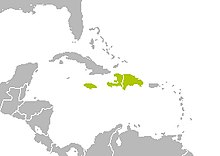Golden swallow (bird)
| Golden swallow | |
|---|---|
 |
|
| Adult of the subspecies sclateri perching on a nest box | |
| Scientific classification | |
| Kingdom: | Animalia |
| Phylum: | Chordata |
| Class: | Aves |
| Order: | Passeriformes |
| Family: | Hirundinidae |
| Genus: | Tachycineta |
| Species: | T. euchrysea |
| Binomial name | |
|
Tachycineta euchrysea (Gosse, 1847) |
|
 |
|
| Range in yellow | |
| Synonyms | |
|
Hirundo sclateri Cory, 1884 |
|
Hirundo sclateri Cory, 1884
The golden swallow (Tachycineta euchrysea) is a passerine in the swallow family, Hirundinidae. Two subspecies are recognised, the Jamaican T. e. euchrysea and T. e. sclateri of Hispaniola (Haiti and the Dominican Republic). It usually inhabits the hills on the interior of islands, preferring open country. Currently, this swallow is restricted to isolated montane forests that primarily consist of the Hispaniolan pine. This species is considered to be a vulnerable species by the International Union for Conservation of Nature (IUCN), although the nominate subspecies, T. e. euchrysea, is likely extinct. The exact cause of extinction is unknown, but likely factors include predation by mammals and habitat loss, although the habitat loss theory is not supported by very much evidence. The last sighting of the nominate subspecies was in Hardwar Gap (located on the boundary between Saint Andrew and Portland parishes), with three birds being seen on 8 June 1989.
A relatively small swallow, the nominate subspecies has bronze upperparts and bronze sides of the head. The ears and lores are duller and the forehead area is more green than bronze. The shoulders, back, rump, and uppertail-coverts are, on the other hand, a coppery-bronze colour. The lesser and median coverts are more coppery, with the greater and primary-wing-coverts being more of a dusky green. The primaries, secondaries, and tail are a dusky bronze-green. The underparts are mostly white. The legs, feet, and irides are dark brown, and the bill is black. The female is similar but with a mottled grey-brown breast and occasionally throat and undertail-coverts. The juvenile is also mottled-grey brown, in addition to it being duller overall. The extant subspecies, T. e. sclateri, is primarily differentiated by its more deeply forked tail, blue-green forehead and uppertail-coverts, and blue-black wings and tail.
...
Wikipedia

